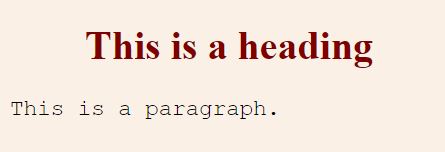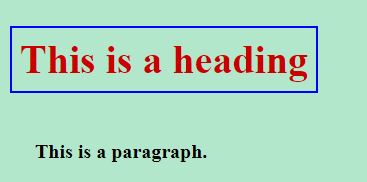CSS Inclusion
How To Add CSS
There are three ways to insert CSS in HTML documents.
- Inline CSS
- Internal CSS
- External CSS
1) Inline CSS:
Inline CSS is used to apply style on a single line or element.
Example:
file name- index.html
<!DOCTYPE html>
<html>
<head>
<title>Inline CSS</title>
</head>
<body>
<h1 style="color:red;text-align:center;">This is a heading</h1>
<p style="color:blue;">This is a paragraph.</p>
</body>
</html>
This will produce the following result −

2) Internal CSS:
Internal CSS is used to apply CSS on a single document or page.
It is written inside the <style> tag within head section of html. Rules defined using this syntax will be applied to all the elements available in the document.
Example:
file name- index.html
<!DOCTYPE html>
<html>
<head>
<title>Internal CSS</title>
<style>
body {
background-color: linen;
}
h1 {
color: maroon;
margin-left: 40px;
}
p {
font-family: 'Courier New', Courier, monospace;
font-size: 18px;
}
</style>
</head>
<body>
<h1>This is a heading</h1>
<p>This is a paragraph.</p>
</body>
</html>
This will produce the following result −

3) External CSS:
External CSS is used to apply CSS on multiple pages or all pages.
We write all the CSS code in a separate CSS file. Its extension must be .css for example style.css
This CSS file should be linked to html pages using <link> tag in <head> section.
Example:
file name- index.html
<!DOCTYPE html>
<html>
<head>
<title>Internal CSS</title>
<link rel="stylesheet" href="./style.css">
</head>
<body>
<h1>This is a heading</h1>
<p>This is a paragraph.</p>
</body>
</html>
file name- style.css
body {
background-color: rgba(150, 223, 186, 0.726);
}
h1 {
color: rgb(202, 0, 0);
border: 2px solid blue;
display: inline-block;
margin-top: 20px;
padding: 6px;
}
p {
margin-left: 20px;
font-weight: bold;
}
This will produce the following result −
